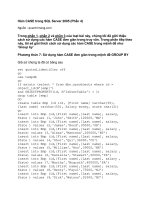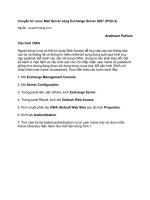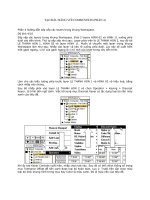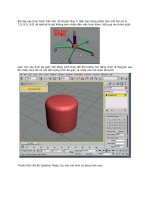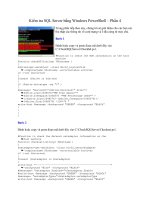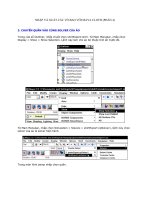Intrusion Detection Utilizing Ethereal phần 4 ppt
Bạn đang xem bản rút gọn của tài liệu. Xem và tải ngay bản đầy đủ của tài liệu tại đây (846.59 KB, 10 trang )
31
Starting at Frame 26, Figure 34, is where I am manually trying to connect as administrator to Testman.
They clearly show (password length) that these new login attempts are not NULL sessions. Ethereal also
shows that I am attempting to connect to the IPC$ share as administrator, Figure 45.
Figure 44. Login attempt as administrator
Figure 45. Attempt to connect to IPC$ share
Response from Testman is shown below.
Figure 46. Failed login attempt
This was one of my bad passwords, as shown by the Status value of: 0xc000006d. There are several more
unsuccessful attempts all with the same status value. There are several other values and responses that
indicate an unsuccessful login attempt. Some are as simple as “bad password” or “login failure”, while
others are a cryptic hex value. Finally, I type the correct password and I am logged in to Testman.
Figure 47. Successful Session Setup
32
It is obvious that the last authentication attempt was successful, as a flurry of network traffic results.
Also, several new commands are seen and all of the attempts are valid. Several of these commands may
be unfamiliar so I am including a brief chart of common SMB commands and an explanation as a
reference. Use it in conjunction with the Ethereal output.
I am almost there. All I need to do now is connect to the secret share on Testman and read my file.
Remember once again that my IP is (10.0.0.50, Bongo) and Testman is (10.0.0.100). You will probably
be looking at NetBIOS traffic with IP’s only and not the resolved names, for increased speed.
Figure 48. SMB Traffic after a (GUI) share connection
I authenticate to the secret share (on Windows NT and 2000 authentication is usually based on user
permissions and not passwords per share) as shown in Figure 49. So if I had logged in to Testman as a
normal user and set the Secret share to be administrator only, I would be denied access. You can see
where I actually connect to the share (SMBtconx response in Frame 205, Figure 48). Now I am going to
open info.txt. An SMB Query and Find command locate info.txt and after a lot of extra information from
NetBIOS, I finally read the information I was looking for a long time ago. It reads, “Meeting at 1800…at
the AFCERT”. This is where using the TCP Stream option might prove to be useful. Although it doesn’t
give you in depth technical information, it does allow you to quickly see if a lot of data was transferred
and the shares/files that were accessed. Figure 50, shows the Read Response.
33
Figure 49. Authentication with the Secret share
Figure 50. Reading the contents of info.txt
Before we proceed to techniques used to hack NetBIOS/SMB, lets look briefly at SMB extended security
and encrypted SMB Session Setups. These new features, incorporated in SMB over TCP/IP, can be
found in Windows 2000 and XP. If you’re expecting to review hashes and account password length to
determine if a NULL session was negotiated or if a user account was accessed, you will be in for a
surprise. Encryption, as expected, protects information such as password length and hash values from an
34
attacker sniffing traffic on your network. However, it still shows the name of the user that is logging in.
The figure below shows an example of an encrypted login.
Figure 51. Encrypted Session Setup
The initial connection is slightly different than that of the older NetBIOS session protocol (via TCP 139).
First, the three-way handshake is established over port 445 (shown in Frames 10-13, Figure 51 as
microsoft-ds). Notice how there is no NetBIOS session setup, as SMB now rides directly over TCP.
Now the protocols are negotiated with the destination server indicating that passwords will be encrypted.
Next, the user sends the encrypted password as part of the “Security Blob” field. The server responds
with an error, but this is normal as it indicates “Status_More_Processing_Required”. This means that
there is more authentication information on its way from the client. The second Session Setup Request
contains the final part of the password authentication and contains the username of administrator. You
have to look in the ASCII display section to see this. In the example above, the middle computer
name/username section is: (4e 00 47 00 61). This translates to the ‘GO’ in BONGO and the ‘a’ in
administrator. In the case of a NULL session the above sequence would be (4e 00 47 00 00). Notice how
the last value is 00, which indicates a NULL username. Also, a NULL session will typically have a
security blob length under 100, while an authenticated login will be in the area of 150 to 250.
And that is it!!! This will give you an idea of what normal NetBIOS/SMB traffic looks like and better
prepare you to spot hackers/brute forcing etc….
35
PART II: Hacking NetBIOS/SMB
This section will concentrate more on the Ethereal output of intrusion/enumeration attempts and not the
actual commands used to hack NetBIOS.
LanGuard: Fast tool that can scan a single computer or domain and enumerates shares, usernames,
registry entries, etc. LanGuard also has other scanning capabilities.
Redbutton Hack:
Is a very old hack, affecting Windows NT Servers older than SP3. New NT/2000 servers can still give up
information if not configured properly, and you never know when an admin will put a default server up.
It took advantage of the NT NULL Session to determine current Administrator name, all available shares,
and open registry entries. The redbutton tool did it automatically. These are some of the commands it
used.
First I create a NULL session with Testman:
c:\ net use \\10.0.0.100\ipc$ “” /user:administrator
Figure 52. Successful NULL session login
There are a couple of interesting things here. First, look how bongo (10.0.0.50) attempts to connect to
port 445 (microsoft-ds) first. This is the equivalent of port 139 for Windows 2000 and XP. Testman
sends a reset, bongo then sends the SYN to port 139, the three-way handshake is established, and finally
session and protocols are negotiated. Now we see that a session setup is requested. The request is a
NULL session with administrator as the user. The traffic looks exactly the same as in the “normal traffic”
section, and is successful.
36
Now I can list shares that I normally would not be able to see: c:\ net view \\10.0.0.100
Figure 53. Intruder enumerates shares
Then I determine the SID (Security Identifier) of Testman:
C:\ user2sid \\10.0.0.100
“testman”
37
Now using this information, I determine the administrator’s name (even if it has been changed):
C:\ sid2user \\10.0.0.100
5 21 713231380 198978898 14044502 500
One of Ethereal’s shortfalls is analyzing named pipes (/PIPE) and other more complex Microsoft
functions. With the latest edition, its capabilities come very close to that of Microsoft’s Network
Monitor. Still, even in earlier versions of Ethereal, it is possible to see what data was transmitted.
Figure 54. Ethereal version 0.8.19 displays the admin account
As you can see the prior version of Ethereal is not as detailed as 0.9.1. The new dissectors have greatly
improved the usefulness of reviewing named pipe network captures. So the hacker has confirmed that the
Administrator account is truly called administrator. Now it is time to brute force the account.
38
NAT (NetBIOS Auditing Tool) by Rhino9
NAT is so easy to use it’s scary. All you do is specify the username list, password list and destination and
it does the rest for you:
C:\ nat –u userlist1.txt –p passlist.txt >> output.txt
I removed all usernames, except administrator, since we already determined that using the NULL session.
Also, I cheated and added the real password at the end of the password list for purposes of this paper (I
didn’t want to have to wait that long). You probably already have an idea what the failed login and
successful login attempts will look like.
Turns out that NAT makes the traffic look quite different. Since the password guessing attempt is
performed through the command line, the results are actually clearer to read. Also, NAT specifies that
passwords will be sent in the clear (no hashing, so ethereal will easily pick this up).
Figure 55. Brute forcing the Administrator account
The initial responses from Testman clearly show denied access.
Figure 56. Failed Session Setup
39
Now, what does the successful login look like?
Figure 57. Login attempt using password of windmill2
Figure 58. Positive response from Testman
The hacker now has the password to Testman and can use Lophtcrack to dump the remote registry.
Lophtcrack:
Lophtcrackv3 has the ability to dump passwords from a remote registry. It does not work on a computer
with Syskey installed or on Windows 2000. All I do is fire up LC3 and request a Security Accounts
Manager (SAM) database dump from Testman. There are two ways you can analyze remote registry
activity either use the main layout or use TCP Stream. The TCP Stream method gives much clearer
information as shown by Figure 59.
40
Figure 59. TCP Stream of remote registry access
You can see where the registry is being accessed, including the SAM. In the second half of the TCP
Stream (on the next page), it is clear that two usernames (hacker and daviesd) are having their SAM
information dumped. The numbers that can be seen are the hashes being sent across the wire by our
friendly tool Lophtcrack. All I need to do now is run Lophtcrack on these passwords and I will have all
of the accounts. Lets try it out and see how long it takes.
Figure 60. LC3 in action
